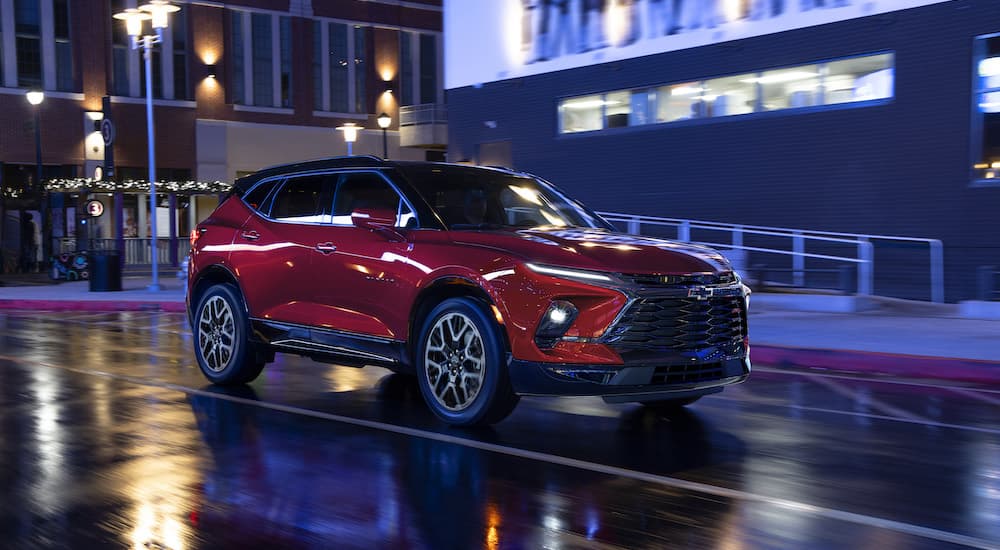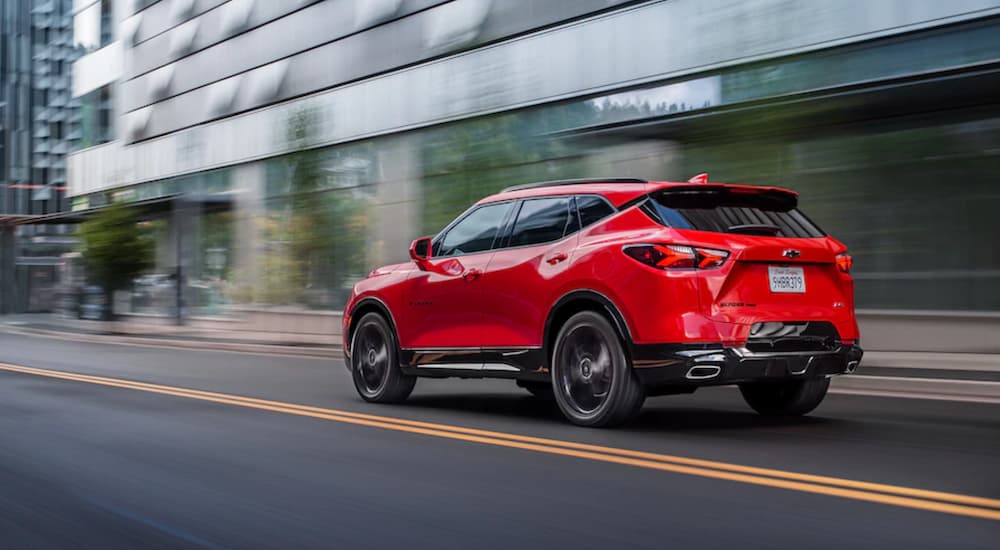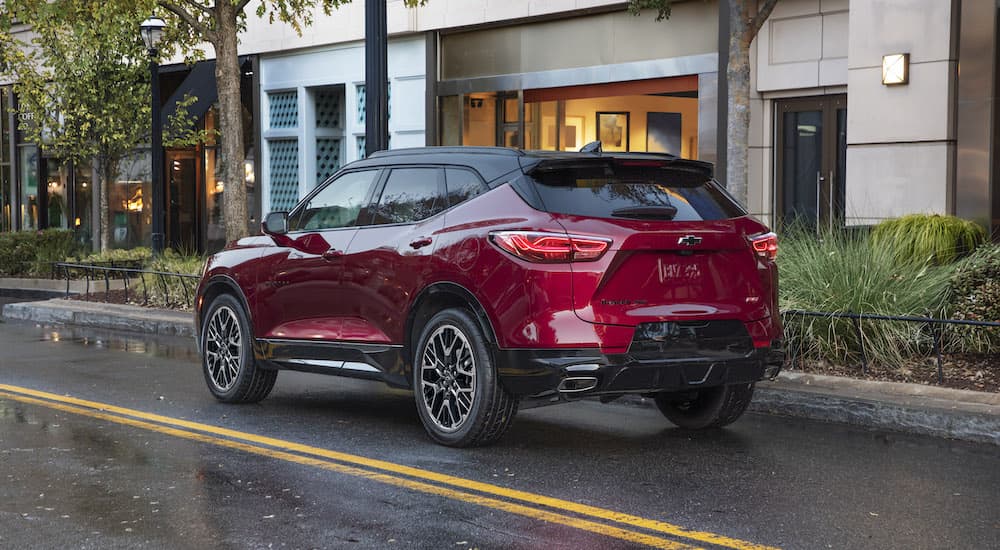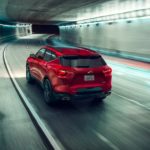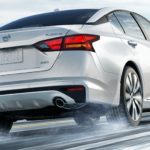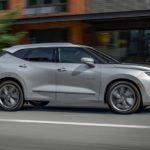A midsize SUV that’s fun to drive and offers plenty of cargo space, the Chevy Blazer is a popular vehicle everywhere, from showroom floors to online car sales. While new models offer all of the latest features, used models are easier on the wallet and can still bring plenty to the table. Of course, it takes a little extra research to delve into the pre-owned market, but that’s where we come in. Let’s break down five important factors to consider when shopping for a used Blazer.
#1. Don’t Get Confused by Chevy’s Many Blazers
Chevrolet has been using the name “Blazer” for decades now. The first Blazer, a full-size SUV, debuted for the 1969 model year. Many of its components were also used for Chevy’s C/K-series pickups, and it shows. The first generation looks very much like a pickup truck with a cover over the bed. The Blazer went through a few generations, its style and size changing over the years to keep up with the times, but it was discontinued after the 2004 model year.
The TrailBlazer was originally released as a trim package on the 1999 Blazer, which would explain why the name is so similar. It was spun off into its own unique model in 2002 and was produced through the 2009 model year. The Blazer nameplate was revived for the 2019 model year, now a midsize crossover with unibody construction rather than a body-on-frame full-size SUV. The Trailblazer name was revived in 2021 as a subcompact crossover, a far cry from the large, off-road capable TrailBlazer of yore and still a completely separate model from the similarly-named Blazer.
So far, we have four distinct vehicles, all bearing similar or identical names: Blazer (1969-2004), Blazer (2019-present), TrailBlazer (2002-2009), and Trailblazer (2021-present). As if that wasn’t already enough to keep track of, Chevy is throwing a new Blazer into the mix for the 2024 model year: the Blazer EV. While all of the other vehicles we’ve mentioned so far run on traditional combustion engines, this one is a fully electric vehicle. While it’s taking on the Blazer nameplate, the EV is actually a completely new model with its own design inside and out.
For the rest of this article, we’re going to focus on the Blazer that debuted for the 2019 model year. Since the old run of the Blazer was discontinued almost twenty years ago, you’re not too likely to come across it on a used car lot. Still, all of these nameplate revivals, spinoffs, and vehicle “families” can get confusing, so it’s best to know what the landscape looks like before you get lost in the weeds.
#2. Keep an Eye on the Drivetrain
Of course, one of the most important aspects of any vehicle is what’s under the hood. Over the years, Chevy has offered a few different engine choices for the Blazer. All three of them come with a nine-speed automatic transmission and have an engine start/stop function to help save fuel while idling.
The least powerful of these is a 2.5-liter inline-4 engine that offers 193 horsepower and up to 188 lb-ft of torque. Unlike the Blazer’s other engines, it can only come with front-wheel drive, so drivers looking for the extra traction provided by all-wheel drive should avoid it. The 2.5L was the base engine from 2019 to 2021 before it was dropped in 2022.
The most powerful option to date is a 3.6-liter V6 engine that can provide 308 horsepower and up to 270 lb-ft of torque. The extra oomph this engine provides can come in handy when passing on the highway, and when paired with all-wheel drive, it can unlock a towing capacity of up to 4,500 pounds. This engine has been available since the new Blazer’s 2019 debut and is still an option as of the 2023 model year.
Splitting the difference between the two is a 2.0-liter turbocharged inline-four, with 228 horsepower and up to 258 lb-ft of torque. Like the V6, this engine can be paired with either front-wheel drive or all-wheel drive. While it doesn’t offer the acceleration or towing capacity of the V6, it’s plenty powerful for getting around town and cruising down the highway and has better fuel economy. The turbo four was introduced for the 2020 Blazer and has been the base engine since the 2.5L was dropped for the 2022 model.
#3. Know Your Trims
The Blazer trims can be divided into four main categories: L, the LT trims, RS, and Premier. When shopping used, you may not be able to have your pick of any trim level, but it’s still good to understand what the different trims mean. Some distinctions are more surface level, like the exterior style and interior materials, but others are pretty significant, like powertrain and safety features.
The L and LT trims are the most basic and most affordable. On the used market, you’ll find trims labeled L, LT, 2LT, and 3LT. The L trim isn’t offered on the 2022 and 2023 models since it featured the engine that was discontinued after 2021. While L models may lack all-wheel drive and more advanced driver assist tech, you’ll still get a fair range of features, including dual-zone automatic climate control, push-button start, and an infotainment screen compatible with Apple CarPlay and Android Auto.
The LT trim (aka 1LT) is still fairly basic but has a few extra standard features and more optional packages available than the L. The 2019 LT comes standard with an eight-way power adjustable driver’s seat and tinted windows. In 2020 and 2021, standard satellite radio was added to the trim. In 2022, the trim was dropped.
In the 2019 model year, the 2LT trim came standard with the more powerful V6 engine. From 2020 onward, it comes with the turbo inline-four instead. In 2021, the 2LT gained the Chevy Safety Assist package as a standard feature. The 3LT trim is the nicest of the LT trims and offers a good handful of luxury features. It has all of the upgrades of the 2LT plus leather interior and heated front seats. The 2020 3LT also comes standard with a six-way power-adjustable front passenger seat, remote start, basic driver aids, and a programmable power tailgate.
The RS trim is sportier, with better handling and a bold exterior style. It consistently comes standard with the V6 engine, giving it plenty of power and towing capacity. It also has standard features like larger wheels (20 inches rather than 18) and built-in navigation. At the Premier level, you get the most luxury features. The 2019 model boasted an eight-speaker Bose audio system and heated and ventilated front seats. In 2020, it gained standard memory settings for the driver’s seat and ambient interior lighting.
#4. Better Safe Than Sorry
From 2019 to 2023, the Blazer has consistently earned five-star overall safety ratings from NHTSA, so every model year can be considered safe. The availability of driver-assistance features, on the other hand, varies pretty widely from year to year. For 2019, most driver assistance tech was an optional add-on, even at the highest trim levels, though RS and Premier did come standard with Rear Park Assist, Rear Cross Traffic Alert, and Lane Change Alert. For the 2021 model year, the Chevy Safety Assist package was a standard feature on the 2LT trim and up. This package includes forward collision warnings and automatic emergency braking. Since the 2LT became the most basic trim in 2022, Blazers from 2022 and 2023 all come standard with Chevy Safety Assist.
#5. Points for Style
Since its re-emergence in 2019, the Blazer has always been a car with a sharp sense of style. While the grille and front fascia have evolved over the years (and differ from trim to trim), the basic look of the face is pretty similar across all of them. The Blazer was designed to have a unique and recognizable exterior, so they all have narrow headlights, bold angles, and a prominent grille. If you’re a fan of the Blazer’s body design, you should be pretty happy with any model.
One thing that has changed over the years is the paint color options available. The 2019 Blazer came out of the gate with nine choices, which can basically be boiled down to shades of white, red, blue, black, and gray. In 2021, a few new metallics and a third shade of red were made available, plus a bright new option called Cayenne Orange. For 2022, Nitro Yellow Metallic and Blue Glow Metallic were added to the lineup, plus the option to get a contrasting color on the roof. Chevy added a few more colors in 2023, but other than Copper Bronze, they’re basically different shades of colors that were already available. So if you like red or basic black, any year is fine, but if you like to stand out with bold colors like yellow or orange, you’ll want to narrow your search down to more recent models.
